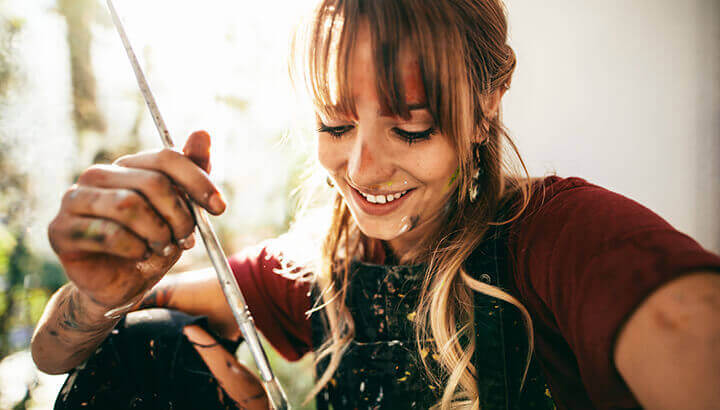
As a person with generalized anxiety disorder, I tend to get mentally overloaded pretty often. Sometimes this happens because of small day-to-day things such as unexpected events, surprise errands, mix-ups at the bank, or my son having an especially crabby day. I try to keep an even keel and breathe deeply and steadily through the twists and turns, but when things pile up, I sometimes find myself in brain-melt territory.
Once I’m in this state of overload and panic, it’s a slow process to dig myself out. Until I get myself out of overload mode, I am unable to be productive or function very well at all, in any area of life. Needless to say, I don’t like to stay in these holes long and I try to avoid them whenever possible. Sometimes this is much easier said than done.
My anxiety was much worse when I was a kid, and I’ve since developed several helpful ways to cope. A few of these include meditation (a big one for me), deep breathing, exercise, music and painting. For this article, I’d like to focus on painting, because it really helps me to center my mind and break out of the kind of stress cycle that leads me to full-fledged mental overload.
At the end of a hard day, once my son is tucked away in bed, I often like to dive into painting. I personally like to use watercolors and sharpies (okay, so it’s part painting, part drawing, but it works for me). Sometimes I dabble in acrylics, too. When I paint, I don’t like to have a plan. I set out a white canvas, poster board or watercolor paper, and line up all of my colors. I then clear my mind, put on some music and just follow my paintbrush or marker. Whatever color comes to mind, I use it. Whatever direction a line wants to go, I follow.
Sometimes the end result looks good, and sometimes it doesn’t. When it doesn’t, I sometimes do more and end up with something surprisingly pleasing (I call this process “damage control”). Other times, the end result is not so stellar. Either way, the process soothes me. It brings my mind into the present, it calms me and it allows me to express myself visually, in abstractions I would not be able to express any other way. It’s highly therapeutic. If I’m already overloaded, doing art helps me to unravel the stress and get back to being present.
This works for me and I’ve talked to many other people who also use art as a release and a therapy. The following are a few reasons why art can be so therapeutic.
Art can help to relieve stress
I have tons of anecdotal evidence to support this, but there is scientific evidence, as well. Research has linked the process of creating visual art in various mediums to lower cortisol levels. Cortisol is known as the “stress hormone,” and when it is high, so is your stress level. Studies have found that how “good” your project turns out doesn’t matter… the stress relief is in the process.
Art may lower inflammation
Creating art can help to lower inflammation simply by reducing stress, as chronic stress has been linked to heightened inflammation. However, research has also found that simply looking at a painting that inspires you and fills you with awe can lead to lower levels of inflammatory markers. As inflammation is at the root of many chronic diseases, keeping your levels under control is key.
Art may help to lower blood pressure

Some research has found that simply looking at certain types of artwork — types that are pleasing and soothing to you — may help to lower your blood pressure levels. This is extremely important for your cardiovascular health.
Art is inspiring
When you are filled with inspiration and purpose, there is little to no room in your brain for stress, anxiety and depression. Working on a project that inspires you can lift your mind out of whatever is troubling it, and redirect it to an awesome creative purpose. Whatever medium inspires you, embrace it.
Art can lift your spirits

For me, working on a painting or drawing is an incredibly uplifting process. If art is something you love, diving into it can really improve your mood and increase your sense of well-being. Because of the powerful nature of this practice, art therapy is becoming more popular. On the effects of this practice, the authors of a 2013 article published in the journal Art Therapy wrote that it may, “induce experiences of flow and positive emotions, and to express life purpose and meaning as well as positive emotions.” I’ve certainly found this to be true.
Art can help you make meaningful connections
If you’re feeling lonely, isolated or just stuck in a social rut, consider taking an art class. Doing so can not only help to improve your artistic skills, it can also put you in contact with others working to improve theirs. You’ll be able to meet people with similar interests and goals, and you may find yourself with some lifelong friends.
So, if you’re a person like me who frequently feels like day to day life is a bit much to handle, try fitting some art into your day. Get yourself some paints, some clay, some collage materials or whatever it is you like to work with, then start experimenting. You may find that it’s the perfect remedy to get your brain out of those knots and into the present.
— Tanya Mead

